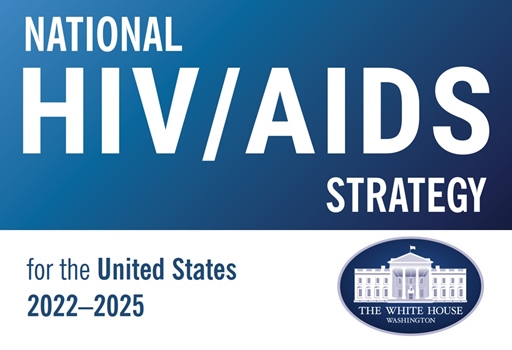
White House Releases New National HIV/AIDS Strategy
Background and Vision Statement
On December 1, World AIDS Day, The White House released the National HIV/AIDS Strategy for the United States: 2022-2025 (NHAS). The 98-page document outlines the framework and direction for the Administration’s policies, research, programs, and planning through 2025 in an effort to end the U.S. HIV epidemic by 2030. According to the new NHAS’s vision statement, “The United States will be a place where new HIV infections are prevented, every person knows their status, and every person with HIV has high-quality care and treatment, lives free from stigma and discrimination, and can achieve their full potential for health and well-being across the lifespan. This vision includes all people, regardless of age, sex, gender identity, sexual orientation, race, ethnicity, religion, disability, geographic location, or socioeconomic circumstance.”
For easy reference, we have summarized the new NHAS’s four goals and specific objectives below, followed by the nine indicators that will be used to track progress. For a more detailed summary, including specific strategies for achieving these goals and objectives, see the document’s sections “NHAS At-a-Glance” (pages 3-10) and “Indicators At-A-Glance” (page 11).
Goal 1: Prevent New HIV Infections
The new NHAS includes four objectives for HIV prevention:
- Increase awareness of HIV;
- Increase knowledge of HIV status;
- Expand and improve implementation of safe, effective prevention interventions, including treatment as prevention, pre-exposure prophylaxis (PrEP), post-exposure prophylaxis (PEP), and syringe services programs (SSPs), and develop new options; and
- Increase the diversity and capacity of health care delivery systems, community health, public health, and the health workforce to prevent and diagnose HIV.
Goal 2: Improve HIV-Related Health Outcomes of People with HIV
The second NHAS goal includes six objectives:
- Link people to care immediately after diagnosis and provide low-barrier access to HIV treatment;
- Identify, engage, or reengage people with HIV who are not in care or not virally suppressed;
- Increase retention in care and adherence to HIV treatment to achieve and maintain long-term viral suppression and provide integrative HIV services for HIV-associated comorbidities, coinfections, and complications, including sexually transmitted infections (STIs);
- Increase the capacity of the public health, health care delivery systems, and health care workforce to effectively identify, diagnose, and provide holistic care and treatment for people with HIV;
- Expand capacity to provide whole-person care to older adults with HIV and long-term survivors; and
- Advance the development of next-generation HIV therapies and accelerate research for an HIV cure.
Goal 3: Reduce HIV-Related Disparities and Health Inequities
The new NHAS also includes six objectives under its third goal:
- Reduce HIV-related stigma and discrimination;
- Reduce disparities in new HIV infections, in knowledge of HIV status, and along the HIV care continuum;
- Engage, employ, and provide public leadership opportunities at all levels for people with or who experience risk for HIV;
- Address social and structural determinants of health and co-occurring conditions that impede access to HIV services and exacerbate HIV-related disparities;
- Train and expand a diverse HIV workforce by further developing and promoting opportunities to support the next generation of HIV providers including health care workers, researchers, and community partners, particularly from underrepresented populations; and
- Advance HIV-related communications to achieve improved messaging and uptake, as well as to address misinformation and health care mistrust.
Goal 4: Achieve Integrated, Coordinated Efforts That Address the HIV Epidemic Among All Partners and Interested Parties
The fourth NHAS goal has five objectives:
- Integrate programs to address the syndemic of HIV, STIs, viral hepatitis, and substance use and mental health disorders in the context of social and structural/institutional factors including stigma, discrimination, and violence;
- Increase coordination among and sharing of best practices from HIV programs across all levels of government (federal, state, tribal, local, and territorial) and with public and private health care payers, faith-based and community-based organizations, the private sector, academic partners, and the community;
- Enhance the quality, accessibility, sharing, and uses of data, including HIV prevention and care continua data and social determinants of health data;
- Foster private-public-community partnerships to identify and scale up best practices and accelerate HIV advances; and
- Improve mechanisms to measure, monitor, evaluate, and use the information to report progress and course correct as needed in order to achieve the Strategy’s goals.
Indicators of Progress
To evaluate progress toward its goals and objectives, the new NHAS establishes the following indicators:
- Increase knowledge of HIV status to 95% from a 2017 baseline of 85.8%;
- Reduce new HIV infections by 75% from a 2017 baseline of 37,000;
- Reduce new HIV diagnoses by 75% from a 2017 baseline of 38,351;
- Increase PrEP coverage to 50% from a 2017 baseline of 13.2%;
- Increase linkage to care within 1 month of diagnosis to 95% from a 2017 baseline of 77.8%;
- Increase viral suppression among people with diagnosed HIV to 95% from a 2017 baseline of 63.1%; this indicator includes subparts stating that the 95% viral suppression target also applies to eight specific demographic groups that are disproportionately affected by HIV;
- Decrease stigma among people with diagnosed HIV by 50% from a 2018 baseline median score of 31.2 on a 10-item questionnaire;
- Reduce homelessness among people with diagnosed HIV by 50% from a 2017 baseline of 9.1%; and
- Increase the median percentage of secondary schools that implement at least 4 out of 7 LGBTQ-supportive policies and practices to 65% from a 2018 baseline of 59.8%.
In addition, the new NHAS designates quality of life for people with HIV as the subject for a developmental indicator, meaning that data sources, measures, and targets will be identified and progress monitored thereafter.
For More Information
The U.S. Department of Health and Human Services HIV.gov website has created a web page that describes key features of the new NHAS, as well as a two-page fact sheet.



